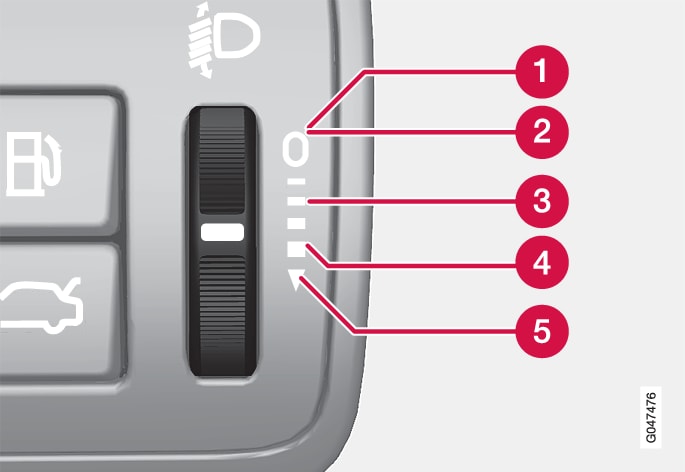Overview, light switches

Knob positions
Note
| Position | Specification |
|---|---|
 | Daytime running lights2 when the car's electrical system is in key position II or the engine is running. Main beam flash can be used. |
 | Daytime running lights, side marker lamps front and position/parking lamps/side marker lamps rear when the car's electrical system is in key position II or the engine is running. Position/parking lamps/side marker lamps when the car is parked. Main beam flash can be used. |
 | Daytime running lights, side marker lamps front and position/parking lamps/side marker lamps rear in daylight when the car's electrical system is in key position II or the engine is running. Dipped beam and position/parking lamps/side marker lamps in weak daylight or darkness, or when the rear fog lamp or windscreen wipers with continuous wiping are activated. The tunnel detection* function is activated. The active high beam* function can be used. Main beam can be activated when dipped beam is switched on. Main beam flash can be used. |
 | Dipped beam and position/parking lamps/side marker lamps. Main beam can be activated. Main beam flash can be used. |
Volvo recommends that  mode is used when the car is being driven, as long as traffic situations or weather conditions are unfavourable for the Active high beam* function.
mode is used when the car is being driven, as long as traffic situations or weather conditions are unfavourable for the Active high beam* function.
Instrument lighting
Different display and instrument lighting is switched on depending on key position; see Key positions - functions at different levels.
The display lighting is automatically subdued in darkness - the sensitivity is set with the thumbwheel.
The intensity of the instrument lighting is adjusted with the thumbwheel.
Headlamp levelling
The load in the car changes the vertical alignment of the headlamp beam, which could dazzle oncoming motorists. Avoid this by adjusting the height of the beam. Lower the beam if the car is heavily laden.

 Only driver
Only driver Driver and passenger in the front passenger seat
Driver and passenger in the front passenger seat Occupants in all seats
Occupants in all seats Occupants in all seats and maximum load in the cargo area
Occupants in all seats and maximum load in the cargo area The driver and maximum load in the cargo area
The driver and maximum load in the cargo area
Cars with active Xenon headlamps* have automatic headlamp levelling and are therefore not equipped with the thumbwheel.